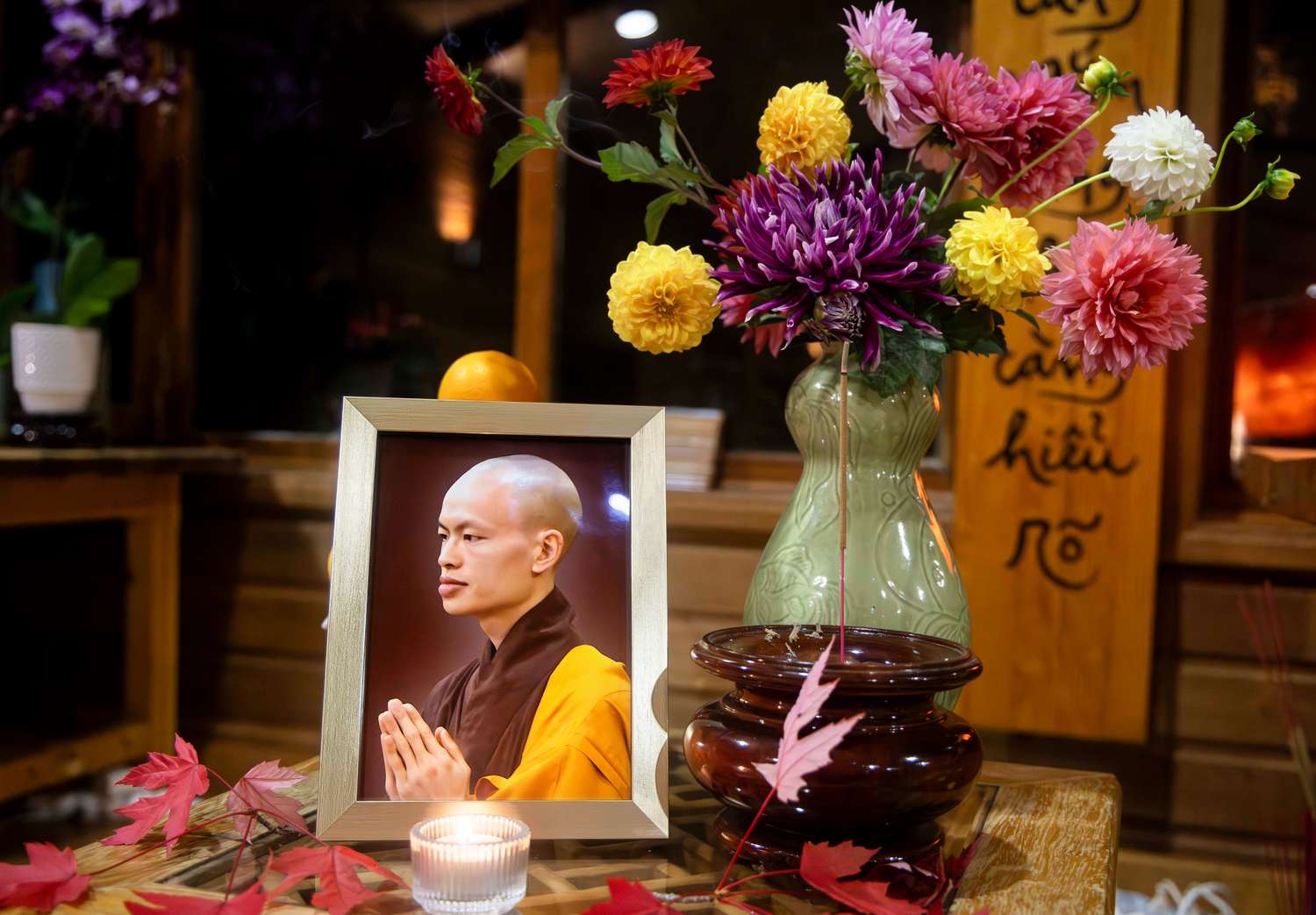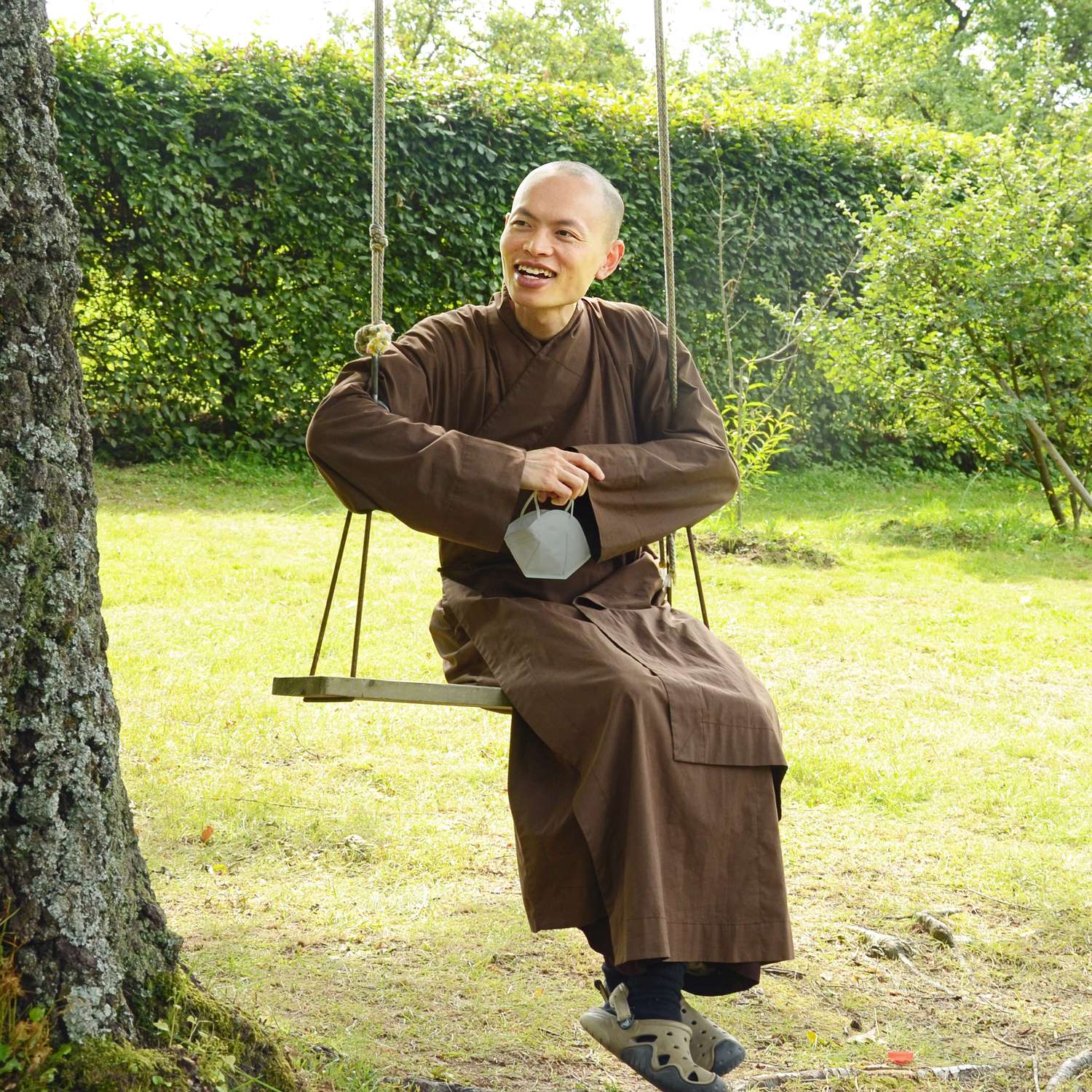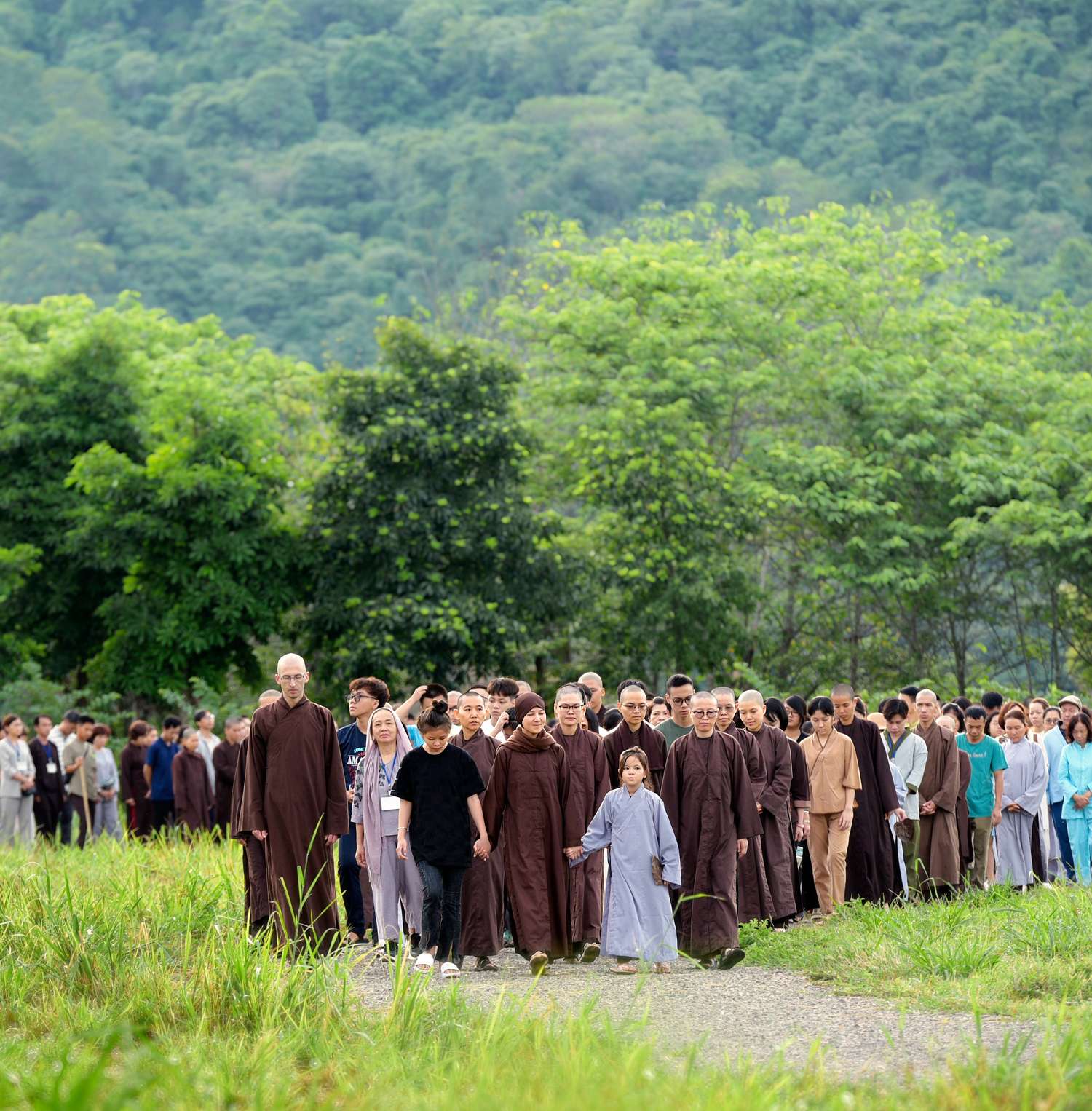I Have Arrived, I Am Home
Brother Chân Trời Hải Thượng
Brother Troi Hai Thuong was born in 1990 and passed away in 2023 at the age of 33. He was ordained as a novice at Thai Plum Village in 2014 in the Red Oak ordination family and received the Great Precepts to become a bhikshu in the “I have arrived, I am home” great precepts transmission ceremony in 2019. After several years of practice and service to the sangha in Thailand, he volunteered to transfer to the European Institute of Applied Buddhism (EIAB) in Germany to help continue Thay’s dream of building sanghas. It was here that Br. Troi Hai Thuong unexpectedly passed away on the morning of 15 October 2023.

Although Br. Troi Hai Thuong no longer manifests in the physical form, we can still get in touch with him through his writings, reflections of a sensitive spirit that earnestly loves life.
The following is a translated excerpt from the Giếng Nước Thơm Trong (Fragrant Well) Newsletter #2 of Thai Plum Village.
Monday
I lay on the green hammock along the corridor right next to the garden at the center of the monks’ residence. The hamlet is usually filled with people, but the lazy days turns it into a deserted place. Everyone was gone so I didn’t need to look for a peaceful space anywhere else. After a long while, a brother passed by seeing me engrossed in reading, he teased, “Are you truly being lazy?” Knowing the brother was only teasing, I just smiled. “Being lazy” is the opposite of “being diligent." How interesting to think that at the beginning of the week, while everyone out there was preoccupied with getting back to their work to earn a living, we did not have any scheduled sitting meditation, walking meditation, or eating in noble silence.
Brother Kai Li shared that when he first came to Plum Village, he was shocked to learn that there was laziness at a monastery! Wouldn’t people usually strive to encourage each other to be diligent? It wasn’t that there were no such things as lazy monks; but to have a “lazy day” as part of the schedule for an entire monastery was something worthy of mention. At that moment, Thay said very earnestly to Br. Kai Li, “Yes, you should be as lazy as possible.” Later, Br. Kai Li realized it was a very deep practice indeed.
Once in a while, we hear people say, “Don’t just sit there, do something.” This is a common thing because our society is a goal-oriented society. We tend to always want to go toward something and always have a specific goal in our minds. On the contrary, Buddhism teaches us the practice of wishlessness. Practitioners of mindfulness would often say, “Don’t just do something, sit there.” Not doing anything is in fact doing something. This teaching reminds us that we do not need to set a goal to run after because everything is already present in us.
I tend to be more successful in being lazy than when we practice noble silence as a whole sangha, when everyone leaves books, pens, papers, internet, devices alone. To be honest, I usually use Mondays as a rest day, to take a break from “work” or to go on outings, not quite in the spirit of “nowhere to go, nothing to do.” Having attended school and worked, participating in the hustle and bustle of society, I still feel guilty being idle. If there are 15 or 30 minutes to spare, I will try to make the most of the time by finding something to do. On the other hand, Zen masters would spend several hours just for tea meditation, being aware and enjoying each movement. Only after becoming a monastic did I realize the image of a monastic sitting doing nothing was in fact not what it seemed. The “business” of monastics is different from that of people in society.
Evening came and the residents of the hamlet had returned from their hidden corners. A few brothers and novices, in their long robes, were chanting and offering food in the Hungry Ghosts Ceremony. The rapid rhythm of the wooden fish drum harmonizing with the chanting voices was very satisfying to the ears. Tonight, there was a scheduled activity, so Br. Tam Nguyen invited me to go for a walk earlier than usual. After asking around, we ended up with four people for the walk. The reverberating sounds of the bell and wooden fish drum had not yet ended, and the chanting lingered:
“May we be born now in the Pure Land within the heart of a lotus flower. In the moment when the lotus blooms, we touch the reality of no-birth and no-dying.”
Brother Tam Nguyen, who used to be a novice in a Buddhist traditional temple, explained that Thay did not make those lines up on his own. To help open the minds of the listeners, our patriarchs had brought into the rites and rituals teachings like:
“The Pure Land is already inherent in the true mind. Amitabha Buddha appears from our true nature, illuminating the three times (past, present, and future) in the ten directions; yet, it does not leave the present moment…”
I was happy to see how much Br. Tam Nguyen had grown. He had become calmer, knowing how to come back to himself, and was an avid reader. As he grew up in a countryside temple that only practiced invoking the name of Amitabha Buddha, I was worried that he would have a difficult time adjusting to the Plum Village environment when I first introduced him to it. But now I could see that he was able to harmonize these two streams.
Friday
I left my room early to go to sitting meditation so that I could enjoy each step on the path to the echo of the Great Temple Bell still reverberating, accompanied by the chanting. Upon arriving at the meditation hall, I saw somebody already there practicing Touching the Earth. Today, many elder brothers have gone out of the monastery, so I felt a little uncomfortable having to sit nearer to the altar during chantings. Being used to living in both a large and a small sangha, I treasured the atmosphere of a powerful chanting each morning calling forth the bright morning light. Each chanting session usually consisted of a chant and a sutra reading.
In Plum Village, we are not required to memorize the sutras or precepts; nevertheless, they seep into our hearts through the repeated practice of sutra reading and chanting throughout the year. Phrases like “We vow to touch the Pure Land with every step, we promise at every contact, to be in touch with the ultimate dimension” may not require much time mulling over the books to understand, partly because they are written in everyday language. If we use the Sino-Vietnamese version, then it would be no different from learning a foreign language because the pronunciation sounds familiar but the meaning is completely different.

This morning, there was only me in my room because all the novices had gone to their language classes. I turned a few pages of a previous edition of the Plum Village newsletter on Br. Tam Nguyen’s study desk to look at the photos. I was drawn by a commentary from Thay on a poem by Bang Ba Lan. It was just the exact thing I had been looking for:
“Who doesn’t need a dream?! According to the practice of Plum Village, we need to find a way to realize our dream today… I myself, I think I can reach my hand out to touch my dream at any moment in my daily life.”
This paragraph reminded me of a time in Germany, when a laywoman asked Thay now that he was advanced in age if he had any dream that was unfulfilled. Thay answered,
“Everyday, Thay is able to live and do the things he likes. Thay no longer has any projects or dreams.”
What Thay emphasized was that, we could touch our dreams right away if we wanted to. How? Thay had already thoroughly taught us. Countless times, we, monks and nuns, sang “It needs you to breathe gently for the miracles to be displayed” (from the song/poem “Our True Heritage”). During a sitting meditation, we might again hear Thay’s warm voice in our ears:
“Dear Lord Buddha… when I breathe in, I see that I have arrived. When I breathe out, I see that I am home. I have come home to the present moment. This is my true homeland. I have arrived, in touch with the wonders of life, with the Pure Land in the present moment. This can be done within one in-breath or one out-breath. If I am able to arrive, to come home, then what more do I need to do? I can enjoy myself as I please in the Buddha Land.”
Like the word “happiness,” the phrase “right away” has become so familiar to the ears that many people in our sangha have forgotten its true value. Was it just meant to fulfill the preferred taste of “instant noodles” of modern day? The teachings of the Buddha transcend time, if we cannot eat them right away in this moment, then we will never be able to taste them. Now or never!
I was planning to reserve Friday evening to find the last few pieces of information for my article. I felt partly pressured, partly relaxed. I went to the online temple, “the Country of the Present Moment,” (plumvillage.org) to look for Thay’s calligraphy but none seemed satisfactory. There must be good ideas I could pick from the storage of Thay’s Dharma talks; but it was so vast, how could I locate them?
Wandering around, I coincidentally came across an article by Br. Minh Hy sharing about something Thay taught:
“The first fruit of the Plum Village practice ‘I have arrived, I am home’ is a little different from the fruit of the traditional practice ‘Stream-enterer.’ With ‘Stream-enterer’, one still has to continue going, whereas with ‘I have arrived, I am home,’ one no longer needs to search for anything more. ‘No need to search further’ (Người chẳng tìm cầu chi nữa) – this is a very good phrase; we need to write it down. It would be a pity if we lose it. Whoever has realized this fruit of the practice, looking at them we would know right away; no need for them to say anything.”
The entire parallel verses were as follows:
Tịnh độ nơi đây thích ý rong chơi người chẳng tìm cầu chi nữa.
Bản môn bây giờ phỉ lòng an trú ta há theo đuổi gì thêm.
The Pure Land is here, roam as you wish; no need to search further.
The ultimate dimension is now, dwell here to your heart’s content; no need to pursue anything more.
I was not sure which meditation hall they were in. Unable to find the calligraphy I needed, I was about to give up. It probably doesn’t really matter whether the article has calligraphy or not. The computer room was empty, except for one younger brother watching a recording of an evening of meditative music. There are many kinds of entertainment in Plum Village. These evenings of meditative music are of the highest quality, because more has been invested in the content of each performance. My computer had no speakers and the headphone jack was broken, so I watched a small segment from his computer. He told me that the entire evening only had one short story which was read in several parts weaving in between pieces of music. It turned out, Thay had a short story, called “The Tale of a River” (Câu chuyện của dòng sông):
“During the night, the river went back to herself. She could not sleep. She listened to her own cries, the lapping of the water against the shore. This was the first time she had ever listened deeply to herself, and in doing so, she discovered something very important: her water was made of clouds. She had been chasing after clouds and she did not know that clouds were her own nature. The river realized that the object of her search was within her. She touched peace. Suddenly she could stop. She no longer felt the need to run after something outside herself. She was already what she wanted to become. The peace she experienced was truly gratifying and brought her a deep rest, a deep sleep.”
When we chase after an object, wanting to grasp it, we will suffer. When we do not have anything to pursue, we will also suffer. If you have been a river, if you have ever chased after a cloud and suffered, lamenting because you felt lonely, please take hold of your own hand like you are holding the hand of a friend. Contemplating deeply, you will see that the thing you are looking for has been here all this time, that is yourself! You are already what you want to become.
It was still a story of the seeker and the thing being sought. “Who seeks, yet who attains?” Looking for a quiet place, I took my hammock and a few books with me: The Miracle of Mindfulness, The Sun My Heart, Fragrant Palm Leaves… to review the most distilled insight of Thay’s early teachings that I had marked for my article.
“[We] are used to living in birth-and-death, and [we] forget about no-birth-and-no-death. A wave also lives the life of water, and we also live the life of no-birth-no-death. We only need to know that we are living the life of no-birth-no- death. All is in the word ‘know.’ To know is to realize. Realization is mindfulness. All the work of meditation is aimed at awakening us in order to know one and only one thing: birth and death can never touch us in any way whatsoever.”
from The Sun My Heart

Closing the book, I looked up and saw in the large glass door a reflection of myself lying in the hammock under the eaves; my back turned toward the sunlight, blending colors for the hills to be green and floating swirls of clouds white. Leaves were falling everywhere as I hung in midair. The lofty white clouds were beautiful; surely somewhere there was a river holding onto the clouds in its heart and yet was still restless. The reflection of the clouds drifted by; someone’s small calligraphy behind the glass door in the room caught my sight: “What more are we looking for? This is it!” (Ta còn tìm cầu chi nữa? This is it!) Right there, that’s it!